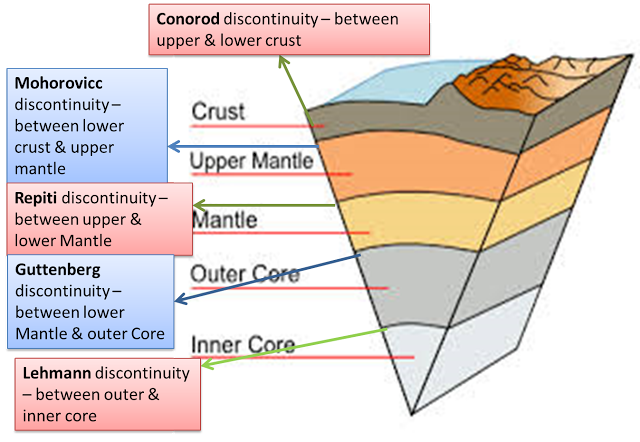Earth’s interior is made of different kinds of materials. Each of those materials are different from each other by their physical and chemical properties, such as temperature, density etc. Unique layers are there according to their characteristics inside the earth. All those layers are separated from each other through a transition zone. These transition zones are called discontinuities.
There are five discontinuies inside the earth.
Conrad Discontinuity: Transition zone between SIAL and SIMA.
Mohorovicic Discontinuity: Transition zone between the Crust and Mantle.
Repiti Discontinuity: Transition zone between Outer mantle and Inner mantle.
Gutenberg Discontinuity: Transition zone between Mantle and Core.
Lehman Discontinuity: Transition zone between Outer core and Inner core.

Conrad Discontinuity:
The transition zone between thee upper and lower part of the lithosphere, is called as Conrad discontinuity. The name come from the Austrian geophysicist Vector Conrad . Up to the middle 20thcentury the upper crust in the continental region was seen to consist of felsic rock such as granite and the lower one consist of more magnesium rich mafic rocks such as basalt. Therefore, the seismologists of that time considered that Conrad discontinuity should correspond to a sharply defined contact between the chemically distinct layers of SIAL and SIMA. In passing through the Conrad discontinuity the velocity of longitudinal seismic waves increases abruptly from approximately 6to6.5km/sec.
Mohorovicic Discontinuity:
The transition zone between the crust and mantle is called as mohorovicic discontinuity. The mohorovicic discontinuity was discovered by Andrija Mohorovicic in the year of 1909. The Moho lies at the depth of 35km beneath the continents and 8km beneath the oceanic crust. The Moho separates both the continental crust and the oceanic crust from underlying mantle. The Moho lies almost entirely within the lithosphere, only beneath the Mid Oceanic Ridge does it define lithosphere and asthenosphere boundary. Immediate above the Moho velocity of the P wave is 6km/sec and just below the Moho it becomes 8km/sec. Moho is characterised by up to 500km thick.
Gutenberg Discontinuity:
The mantle –core transition zone is called Gutenberg discontinuity. In the year of 1912 Weichert Gutenberg was discovered this discontinuity at the depth of 2900km beneath the earth surface. In this zone the velocity of seismic waves changes suddenly. The velocity of P wave decreases and S wave completely disappear at this depth. S wave shear material and cannot transmit through liquid. So, it is believed that the part of above the discontinuity is solid and part of beneath then discontinuity is liquid or molten form. This molten section is thought to be 700°c, hotter than the overlying mantle. It is also denser, probably due to a greater percentage of iron.
It is a narrow ,uneven zone and contains undulations which may be up to 5-8km wide. This undulation is affected by the heat driven convection activity within the overlying mantle. These undulations are also affected by the underlying eddies and current within the outer core iron rich fluids, which are ultimately responsible for earth magnetic field. Here it must be mentioned that the mantle core boundary does not remain constant. As the heat of the earth’s interior constantly but slowly dissipated, the molten core within earth solidifies and shrinks, causing the core mantle boundary to slowly move deeper and deeper within the earth’s core.
Repiti Discontinuity
it is the transition zone between Outer mantle and Inner mantle.
Lehmann discontinuity
It is the transition zone between outer and inner core. The Lehmann discontinuity is an abrupt increase of P-wave and S-wave velocities at the depth of 220±30 km, discovered by seismologist Inge Lehmann.It appears beneath continents, but not usually beneath oceans, and does not readily appear in globally averaged studies. Several explanations have been proposed: a lower limit to the pliable asthenosphere, a phase transition,[and most plausibly, depth variation in the shear wave anisotropy.
Source(s):
Wikipedia

Pingback: Structure and composition of the Earth | Rashid's Blog
Thank u srr….quiet informative and helpful…
LikeLike
Pingback: Asthenosphere | Rashid's Blog
Sir, I have a confusion. You previously told that Lehmann discontinuity is a transition zone between upper and lower core. Then why later on explain it to cover in upper mantle?
LikeLike
Thank you so much for the detailed description and explanation.
LikeLike
Hello Mr. Rashid Fardi! Thank you very much to this very helpful article of yours and in summarizing this also I could not find this in your sources but this has been a way to researching to another parts of the mantle and maybe find out a little bit more. I seriously Thank you very much for this. God Bless!
LikeLike
Simple and comprehensive description of discontinuities of earth
LikeLike
Thank you sir .keep up the good work
LikeLike
Hi thank you indeed for writing such an informative article, and I hope thousands of people can benefit from it. I appreciate the endeavor taken out by yours team. I recently came across a website Geo Studies Organisation, and a blog; Geostudies 2020, while i was searching some precious gemstones. These websites provided me an awesome information about the gemstones. These two are the perfect sites for getting knowledge about the subjects of earth science. Layered Structure of Earth,
LikeLike